Charts and graphs have long been part of research papers. With the growth of computer capabilities that can capture the world visually, research papers today typically include more charts, graphs, and images than those produced in previous years.
When you insert an image into your text, you must make some physical decisions. One of the most common choices is to place the image to the right or left of your text.
Figure 9.6

Another choice is to move the text down to create page-wide space for the image. In such situations, the image is typically placed above the related text. This format is usually used at the beginning of a document where the image treatment doesn’t break up the text.
You should choose visuals to advance your argument rather than just to decorate your pages. Just as you would not include words that are fluff, you should not include meaningless images.
Also, just as you aim to avoid the use of fallacies in your text, you also need to be careful not to use fallacious visuals. (See Chapter 4 "Joining the Conversation", Section 4.3 "Rhetoric and Argumentation" for more on fallacies.) For example, if you were arguing for or against the proposition that big dogs make good pets for families, you might show a picture of a Rottweiler. Figure 9.7 shows how the “for” side could choose a docile example (Rottweiler A), while the “against” side could choose a ferocious example (Rottweiler B) in order to support their respective claims.
Thanks to common programs such as Photoshop, you can easily alter a photo, but make sure to do so ethically. For example, say that you are making an argument that the Moser Company unfairly hires only young people and disposes of employees as they age. You decide to show a photo of some of the employees to make your point. You crop the original photo in Figure 9.7 (Moser Company A) into the version shown as Moser Company B. This cropping choice would be an example of a faked, misleading photo and would be unethical.
More than likely, you have seen tables or graphs that paint a reality that is not exactly accurate. For example, the two graphs in Figure 9.7 could be used as proof that “twice as many” high school teachers as grade school teachers choose to use computer-driven whiteboards. Graph A seems to support this statement nicely. If you look at Graph B, however, you realize that the entire sample includes only three teachers, so “twice as many” means, literally, two out of three—an inadequate sample that leads to neither impressive nor convincing data. Be very careful not to misrepresent data using tables and graphs, whether knowingly or accidentally.
Visuals, like oral or written text, can make ethical, logical, and emotional appeals. (See Chapter 4 "Joining the Conversation", Section 4.2 "Recognizing the Rhetorical Situation" for more on rhetorical appeals.) Two examples of ethical appeals are a respected logo and a photo of the author in professional dress. Graphs, charts, and tables are examples of logical appeals. For the most part, nearly all visuals, because they quickly catch a reader’s eye, operate on an emotional level—even those that are designed to make ethical and logical appeals.
Consider the following options as you choose visuals for your work:
Write a journal or blog entry or a short essay that addresses some or all the following questions: